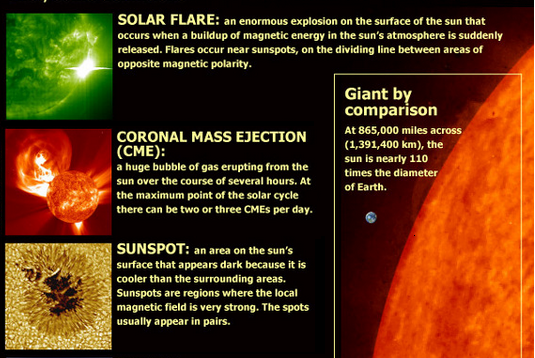Important Facts For Prelims
Solar Flare
- 08 Jul 2023
- 4 min read
Why in News?
Recently, the Sun emitted an X-class solar flare, disrupting radio communications over parts of the United States and the Pacific Ocean.
According to the National Aeronautics and Space Administration (NASA), the flare is classified as an X1.0 flare.
What is a Solar Flare?
- About:
- A solar flare is a tremendous explosion on the Sun that happens when energy stored in 'twisted' magnetic fields (usually above sunspots) is suddenly released.
- They are seen as bright areas on the sun and they can last from minutes to hours.
- In a matter of just a few minutes, they heat the material to many millions of degrees and produce a burst of radiation across the electromagnetic spectrum, including from radio waves to x-rays and gamma rays.
- They can affect radio communications, power grids and navigation signals and endanger astronauts and spacecraft.
- Categories:
- There are five categories of solar flare according to their brightness in the x-ray wavelengths which include A, B, C, M, and X; each class is at least ten times more potent than the one before it.
- X-class Flares (Big): They are major events that can trigger radio blackouts around the whole world and long-lasting radiation storms in the upper atmosphere.
- M-class Flares (Medium-Sized): They generally cause brief radio blackouts that affect Earth's polar regions. Minor radiation storms sometimes follow an M-class flare.
- C-class Flares: Compared to X- and M-class events, C-class flares are small with few noticeable consequences here on Earth.
- The smallest ones are A-class (near background levels), followed by other flares.
- There are five categories of solar flare according to their brightness in the x-ray wavelengths which include A, B, C, M, and X; each class is at least ten times more potent than the one before it.
Note:
- Solar flares are different from Coronal Mass Ejections' (CMEs), which were once thought to be initiated by solar flares.
- CMEs are huge bubbles of gas threaded with magnetic field lines that are ejected from the Sun over the course of several hours. Although some are accompanied by flares, it is now known that most CMEs are not associated with flares.
UPSC Civil Services Examination, Previous Year Question (PYQ)
Q. If a major solar storm (solar flare) reaches the Earth, which of the following are the possible effects on the Earth?(2022)
- GPS and navigation systems could fail.
- Tsunamis could occur at equatorial regions.
- Power grids could be damaged.
- Intense auroras could occur over much of the Earth.
- Forest fires could take place over much of the planet.
- Orbits of the satellites could be disturbed.
- Shortwave radio communication of the aircraft flying over polar regions could be interrupted.
Select the correct answer using the code given below:
(a) 1, 2, 4 and 5 only
(b) 2, 3, 5, 6 and 7 only
(c) 1, 3, 4, 6 and 7 only
(d) 1, 2, 3, 4, 5, 6 and 7
Ans: (c)







